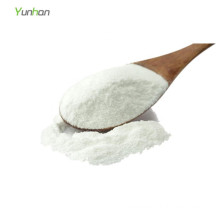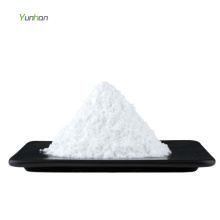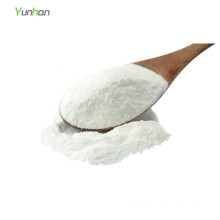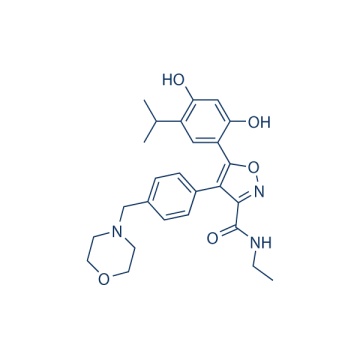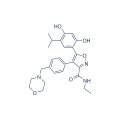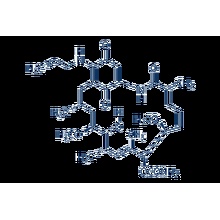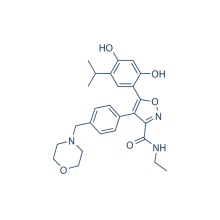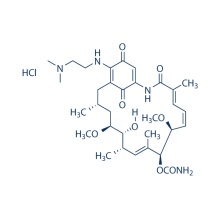Luminespib (AUY-922, NVP-AUY922) 747412-49-3
Product Description
.cp_wz table {border-top: 1px solid #ccc;border-left:1px solid #ccc; } .cp_wz table td{border-right: 1px solid #ccc; border-bottom: 1px solid #ccc; padding: 5px 0px 0px 5px;} .cp_wz table th {border-right: 1px solid #ccc;border-bottom: 1px solid #ccc; padding: 5px 0px 0px 5px;}
Molecular Weight: 465.54 Luminespib (AUY-922, NVP-AUY922) is a highly potent HSP90 inhibitor for HSP90α/β with IC50 of 13 nM /21 nM, weaker potency against the HSP90 family members GRP94 and TRAP-1, exhibits the tightest binding of any small-molecule HSP90 ligand. Phase 2.
Biological Activity
NVP-AUY922 inhibits proliferation of various human cancer cell lines in vitro, with an average GI50 of 9 nM.
The IC50 values of NVP-AUY922 fall in the range of 2 to 40 nM in these
gastric cancer cell lines. IC50 value for the BEAS-2B cells is 28.49 nM.
Treatment with NVP-AUY922 does not influence the expression of HSP90,
but expression of HSP70 gets elevated by NVP-AUY922 treatment.
NVP-AUY922 increases the binding of HSP70 to HSP90. NVP-AUY922 causes
p23 dissociation from the HSP90 complex and can then recruit HSP70 to
the HSP90 complex. After the treatment with NVP-AUY922, expression of
receptor tyrosine kinases including VEGFR1, 2, 3 and PDGFRɑ is
decreased.
A decrease is also noticed in the expression of Akt and
phospho-Akt. Meanwhile, treatment with NVP-AUY922 causes decreased
expression of HER-2 in NCI-N87 cells. NVP-AUY922 treatment results in
binding of HSP90 to client Proteins and setting them up as targets for
degradation by the proteasome. NVP-AUY922 can influence cell growth by
affecting multiple signaling pathways. In addition, treatment with the
Proteasome Inhibitor, MG132, restores expression of thymidylate
synthase, which is decreased by NVP-AUY922. NVP-AUY922 increases the
expression of cleaved caspase-3 leading to Apoptosis in HSC-2 cells.
Treatment
with NVP-AUY922 causes a robust antitumor response and inhibits p-Akt
and VEGF expression in an HSC-2 xenograft model. In BT474, NVP-AUY922
shows complete loss of ERBB2 and substantial depletion of ERα, in
addition to reductions in CDK4 and phospho-ERK1/2.
Protocol(Only for Reference)
Kinase Assay: [3]
Cell Assay: [1]
Animal Study: [3]
Conversion of different model animals based on BSA (Value based on data from FDA Draft Guidelines)
For example, to modify the dose of resveratrol used for a mouse (22.4 mg/kg) to a dose based on the BSA for a rat, multiply 22.4 mg/kg by the Km factor for a mouse and then divide by the Km factor for a rat. This calculation results in a rat equivalent dose for resveratrol of 11.2 mg/kg.
Chemical Information
Molarity Calculator
Dilution Calculator
Molecular Weight Calculator
Contact us if you need more details on Luminespib 747412-49-3. We are ready to answer your questions on packaging, logistics, certification or any other aspects about AUY-922 747412-49-3、NVP-AUY922 747412-49-3. If these products fail to match your need, please contact us and we would like to provide relevant information.
Molecular Weight: 465.54 Luminespib (AUY-922, NVP-AUY922) is a highly potent HSP90 inhibitor for HSP90α/β with IC50 of 13 nM /21 nM, weaker potency against the HSP90 family members GRP94 and TRAP-1, exhibits the tightest binding of any small-molecule HSP90 ligand. Phase 2.
Biological Activity
NVP-AUY922 inhibits proliferation of various human cancer cell lines in vitro, with an average GI50 of 9 nM.
The IC50 values of NVP-AUY922 fall in the range of 2 to 40 nM in these
gastric cancer cell lines. IC50 value for the BEAS-2B cells is 28.49 nM.
Treatment with NVP-AUY922 does not influence the expression of HSP90,
but expression of HSP70 gets elevated by NVP-AUY922 treatment.
NVP-AUY922 increases the binding of HSP70 to HSP90. NVP-AUY922 causes
p23 dissociation from the HSP90 complex and can then recruit HSP70 to
the HSP90 complex. After the treatment with NVP-AUY922, expression of
receptor tyrosine kinases including VEGFR1, 2, 3 and PDGFRɑ is
decreased.
A decrease is also noticed in the expression of Akt and
phospho-Akt. Meanwhile, treatment with NVP-AUY922 causes decreased
expression of HER-2 in NCI-N87 cells. NVP-AUY922 treatment results in
binding of HSP90 to client Proteins and setting them up as targets for
degradation by the proteasome. NVP-AUY922 can influence cell growth by
affecting multiple signaling pathways. In addition, treatment with the
Proteasome Inhibitor, MG132, restores expression of thymidylate
synthase, which is decreased by NVP-AUY922. NVP-AUY922 increases the
expression of cleaved caspase-3 leading to Apoptosis in HSC-2 cells.
Treatment
with NVP-AUY922 causes a robust antitumor response and inhibits p-Akt
and VEGF expression in an HSC-2 xenograft model. In BT474, NVP-AUY922
shows complete loss of ERBB2 and substantial depletion of ERα, in
addition to reductions in CDK4 and phospho-ERK1/2.
Protocol(Only for Reference)
Kinase Assay: [3]
| Kinase assay | NVP-AUY922 is dissolved in DMSO at a concentration of 10 mM. NVP-AUY922 is assessed against HSP90α, HSP90β, GRP94, TRAP-1, HSP72, and topoisomerase II. Profiling against a panel of kinases has been carried out and screening against a panel of additional enzymes and receptors is performed at Cerep. |
|---|
Cell Assay: [1]
| Cell lines | Human gastric cancer cells NCI-N87 |
|---|---|
| Concentrations | 1 μM |
| Incubation Time | 3 days |
| Method | Human gastric cancer cells NCI-N87 (5-7 ×103 in 50 μL/well) are seeded in 96-well plates and incubated at 37 °C for 24 hours, followed by NVP-AUY922 treatment for 1-3 days at 37 °C. After treatment, the cells are assayed by MTT method and analyzed by microplate reader. |
Animal Study: [3]
| Animal Models | Female NCr athymic mice bearing WM266.4 human melanoma xenografts | ||
|---|---|---|---|
| Formulation | In DMSO and diluted in sterile saline/Tween 20 | ||
| Dosages | 50 mg/kg | ||
| Administration | Administered via i.v. or i.p. | ||
| Solubility | 1% DMSO/30% polyethylene glycol/1% Tween 80, 30 mg/mL | ||
| * Please note that Selleck tests the solubility of all compounds in-house, and the actual solubility may differ slightly from published values. This is normal and is due to slight batch-to-batch variations. | |||
Conversion of different model animals based on BSA (Value based on data from FDA Draft Guidelines)
| Species | Baboon | Dog | Monkey | Rabbit | Guinea pig | Rat | Hamster | Mouse |
| Weight (kg) | 12 | 10 | 3 | 1.8 | 0.4 | 0.15 | 0.08 | 0.02 |
| Body Surface Area (m2) | 0.6 | 0.5 | 0.24 | 0.15 | 0.05 | 0.025 | 0.02 | 0.007 |
| Km factor | 20 | 20 | 12 | 12 | 8 | 6 | 5 | 3 |
| Animal A (mg/kg) = Animal B (mg/kg) multiplied by | Animal B Km |
| Animal A Km |
For example, to modify the dose of resveratrol used for a mouse (22.4 mg/kg) to a dose based on the BSA for a rat, multiply 22.4 mg/kg by the Km factor for a mouse and then divide by the Km factor for a rat. This calculation results in a rat equivalent dose for resveratrol of 11.2 mg/kg.
| Rat dose (mg/kg) = mouse dose (22.4 mg/kg) × | mouse Km(3) | = 11.2 mg/kg |
| rat Km(6) |
Chemical Information
| Molecular Weight (MW) | 465.54 |
|---|---|
| Formula | C26H31N3O5 |
| CAS No. | 747412-49-3 |
| Storage | 3 years -20℃Powder |
|---|---|
| 6 months-80℃in solvent (DMSO, water, etc.) | |
| Synonyms | VER-52296 |
| Solubility (25°C) * | In vitro | DMSO | 93 mg/mL heating (199.76 mM) |
|---|---|---|---|
| Water | <1 mg/mL ( | ||
| Ethanol | 31 mg/mL (66.58 mM) | ||
| In vivo | 1% DMSO/30% polyethylene glycol/1% Tween 80 | 30 mg/mL | |
| * <1 mg/ml means slightly soluble or insoluble. * Please note that Selleck tests the solubility of all compounds in-house, and the actual solubility may differ slightly from published values. This is normal and is due to slight batch-to-batch variations. | |||
| Chemical Name | 5-(2,4-dihydroxy-5-isopropylphenyl)-N-ethyl-4-(4-(morpholinomethyl)phenyl)isoxazole-3-carboxamide |
|---|
Molarity Calculator
Dilution Calculator
Molecular Weight Calculator
Contact us if you need more details on Luminespib 747412-49-3. We are ready to answer your questions on packaging, logistics, certification or any other aspects about AUY-922 747412-49-3、NVP-AUY922 747412-49-3. If these products fail to match your need, please contact us and we would like to provide relevant information.
Product Categories : Cytoskeletal Signaling > HSP Inhibitor
Other Products
Hot Products
Astragaloside AChlortetracycline HCl 64-72-2Paclitaxel 33069-62-4Dexamethasone Acetate 1177-87-3Dinaciclib (SCH727965) 779353-01-4CHIR-124 405168-58-3Ro3280 1062243-51-9TAME 901-47-3CCG-1423 285986-88-110058-F4 403811-55-2Dabigatran (BIBR 953) 211914-51-1H 89 2HCl 130964-39-5T0901317 293754-55-9Aprepitant 170729-80-3Turofexorate Isopropyl (XL335) 629664-81-9BMS-378806 357263-13-9
